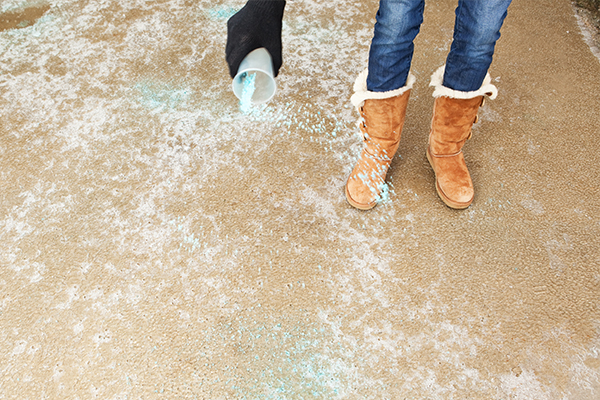Where you live will determine the severity and proximity of the winter seasons. Our friends in Florida are not having conversations about the most effective ways to melt ice, but for business owners in the Midwest, this is a top priority during cold weather.
Being caught off-guard with a flash freeze or early snowfall can leave you (literally) stranded and can make your business a danger to clients. Getting organized and prepared in the autumn can certainly save you a lot of headaches, and you won’t feel rushed when winter arrives.
Determining the right kind of ice melt for you and the amount you will need is based entirely on the temperatures where you live, your budget, and the surfaces you are deicing.
What is Ice Melt?
Basically, ice melt (or deicer) lowers the freezing point of water, which keeps ice from forming and turns it into slush. This prevents ice buildup and makes it easier to clean. Also, Ice melt can be applied before or after snow and ice are already formed.
Many businesses and homes will put deicer on their sidewalks and in parking areas before a drop in temperature or snowfall is forecasted. This allows for a quick cleanup and avoids any potential slips or stuck vehicles.

Which Ice Melt is Right for Me?
Choosing the correct ice melt for your home or business takes a lot of consideration. Your salt will only work properly if it is the correct type for your location, seasonal temperatures, and application surface.
All ice melts come with their own advantages and disadvantages. For example, sodium chloride which is often sold as rock salt is an easy way to slowly melt ice. Since rock salt is one of the cheapest options, it is also one of the most popular. Some disadvantages are that this type can create salt stains around the house and on clothing and has been shown to have negative impacts on the environment.
Time and Temperature
Two of the biggest factors in determining which type of ice melt is best for you come down to time and temperature. How fast and how long does your deicer need to work? And at what temperatures?
As the deicer melts and becomes a solution, it turns into a brine that allows it to separate the ice from the surface underneath. When the deicers are in contact with water, they emit heat, which in turn melts more ice and creates more brine.
Environment
Animals and plants can be affected by the water from the salts. For example, calcium chloride can lead to heavy metal contamination in water and spikes of chloride concentrations in soil. Some ice melts and options are formulated to be more environmentally conscious.
However, you can also lessen the impact your ice melt has on the environment by avoiding over-application and allowing the product time to work before applying more.
Solid or Liquid
The most common type of deicer is solid pellets. These absorb moisture from the ice and soften the bond between the ice and the ground. These pellets are applied using a salt or sand spreader. Solids are easier to store and generally more budget-friendly. However, they require some liquid to become a brine, which can take time or be challenging in extremely cold weather.
In contrast, liquids are more expensive to transport and store and are not ideal for thick, existing, ice. Additionally, liquid ice melt can drain quickly if there is too much precipitation. If the roads are dry, liquid can stick to a road surface which makes it more effective for a longer period.
Ice Melt Comparison Chart
|
Type of Ice Melt |
Lowest Effective Temperature |
Considerations |
|
Calcium Chloride |
-25°F |
• Exothermic • Moderate potential for corrosion and environmental impact |
|
Magnesium Chloride |
5°F |
• Exothermic • Moderate potential for corrosion and environmental impact |
|
Sodium Acetate |
5°F |
• Exothermic • Fast Acting • Safe for the environment, biodegradable |
|
Calcium Magnesium Acetate |
5°F |
• Exothermic • Low corrosion • Safe for the environment, biodegradable |
|
Potassium Chloride |
12°F |
• Endothermic • Slow acting • Safe for the environment |
|
Urea |
15°F |
• Endothermic • Slow acting • Safe for the environment |
|
Sodium Chloride |
20-22°F |
• Endothermic • Toxic to vegetation • Moderate potential for corrosion |
|
Various Blends |
20-22°F |
• Most blends contain 90-99% rock salt (sodium chloride) |
Advantage Salt Supply
We offer two products for our ice melts, which provide a proprietary formula that create ecologically, kid, and pet-friendly products. This formula is also safer for concrete, brick pavers, and landscaping, significantly reducing corrosion of metals common when using straight rock salt or calcium chloride. Our ice melts are granulated to optimize melting power resulting in less wasted material and time. Both our ice melt and rock salt are available by the pallet from Advantage Water Conditioning or by the truckload from Advantage Salt Supply.





